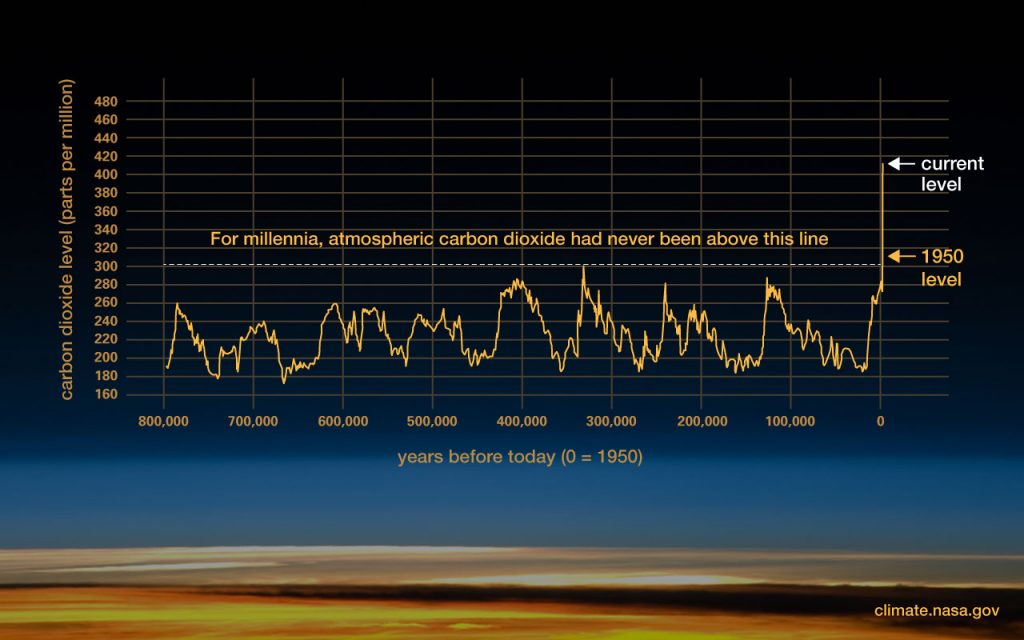

REVIEW
CLAIM: “...What is the likelihood of the climate (which, itself, consists of many variables and not just globally averaged temperature anomaly) is controlled by this 2% perturbation in a single variable?”; “Believing CO2 controls the climate is pretty close to believing in magic.”
A quote on Facebook attributed to Richard Lindzen, a retired meteorologist who has received funding from fossil fuel interests, claims that climate change cannot likely be caused by a “single variable” such as CO2 due to the complexity of the climate system.
Climate is indeed a complex system consisting of multiple variables. However, its complexity does not indicate that scientists do not understand the main variables that are driving contemporary warming.
Since 1950, atmospheric CO2 concentrations have climbed from just above 300 parts per million (ppm) to over 400 ppm (Fig. 1). This change, caused by fossil fuel use, is particularly startling in the context of past atmospheric CO2 concentrations, which ice core reconstructions indicate have fluctuated between around 200 and 300 ppm over periods of thousands of years during the last 800,000 years (Fig. 1).[1,2]
While remaining in the atmosphere, CO2 prevents heat from escaping and consequently warms the surface of Earth – a concept that is popularly known as the greenhouse effect. This theory predicts that the increase in temperature will be proportional to the logarithm of the concentration of CO2, with a time-lag of about 20 years. Figure 2 shows that this is precisely what the data shows, hence providing a strong validation of the theory, in addition to other lines of evidence. “The role of CO2 in warming the Earth was discovered in the mid-19th century,” says James Renwick, a climate scientist at Victoria University of Wellington in a previous review of a similar claim.

Figure 1. Variations in atmospheric CO2 concentration over the last 800,000 years. Source: NASA.

Figure 2. Global temperature plotted against atmospheric CO2 concentration. Note the logarithmic scale of the x-axis is due to the nature of the relationship between greenhouse gases and temperature.[3] Source: Berkeley Earth.
But how can scientists be certain that CO2 is driving today’s warming and not, as Lindzen argues, one of the other several variables of Earth’s climate system? Scientists have calculated the influence of individual variables on Earth’s climate, and consistently find that human activities, dominantly CO2 emissions, have driven warming following the onset of the industrial era (Fig. 3).

Figure 3. Time series of effective radiative forcing (warming) caused by various mechanisms. Note that carbon dioxide (gray) contributes more to warming than all of the other well-mixed greenhouse gases (WMGHG). Note also that the majority of warming is caused by carbon dioxide and other greenhouse gases. Source: U.S. Fourth National Climate Assessment.
“The warming from the late 1800s to the present is all due to human-caused climate change, because natural factors have changed little since then and even would have caused a slight cooling over the last 70 years rather than the warming we have observed”, noted Timothy Osborn, a climate scientist at the University of East Anglia, in a previous review.
Atmospheric observations also support warming driven by greenhouse gases. The scientific understanding of greenhouse gas physics predicts that CO2 would selectively warm the lower section of the atmosphere, called the troposphere, while cooling the upper part of the atmosphere, called the stratosphere. Thus, if CO2 is responsible for Earth’s temperature increase, we would expect to see a simultaneous warming of the troposphere and cooling of the stratosphere[4-6], which is exactly what the data show (Fig. 4).

Figure 4. Global temperature variations in the upper atmosphere (top graph) and in the lower atmosphere (bottom graph) since the 1960s. We observe a warming at the surface and a cooling above, which is consistent with the effect of added greenhouse gases in the atmosphere. Source: Met Office Hadley Centre.
If you are interested in learning more about how carbon dioxide can have such an important effect on global climate when its concentration is so small, read this article in The Conversation.
Updates:
- 9 September 2022: Content related to Lindzen’s “2% perturbation” statement was removed due to a lack of clarity about what perturbation the author refers to.
References
- 1 – Lüthi et al. (2008). High-resolution carbon dioxide concentration record 650,000–800,000 years before present. Nature
- 2 – EPICA Community Members (2004). Eight glacial cycles from an Antarctic ice core. Nature
- 3 – Huang & Shahabadi (2004). Why logarithmic? A note on the dependence of radiative forcing on gas concentration. Journal of Geophysical Research: Atmospheres.
- 4 – Lockwood & Fröhlich (2007) Recent oppositely directed trends in solar climate forcings and the global mean surface air temperature. Proceedings of the Royal Society of London A: Mathematical, Physical and Engineering Sciences.
- 5 – Lockwood (2008) Recent changes in solar outputs and the global mean surface temperature. III. Analysis of contributions to global mean air surface temperature rise. Proceedings of the Royal Society of London A: Mathematical, Physical and Engineering Sciences.
- 6 – Santer et al. (2013). Human and natural influences on the changing thermal structure of the atmosphere. Proceedings of the National Academy of Sciences.


